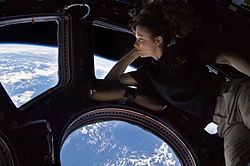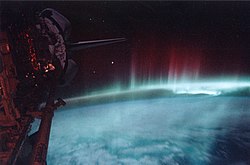Spaceflight
Spaceflight is when an object (or spacecraft) made by man flies into outer space. A spaceflight can occur with or without humans on board.
The Russian Soyuz program, the American Space Shuttle and the International Space Station are examples of manned missions. (Manned means the spacecraft has humans on board.) On the other hand, examples of unmanned flights are space probes which fly into deeper space, and satellites which travel around and orbit the Earth or other planets. (Unmanned means the spacecraft does not have any people on board.) Space probes and satellites are both machines that work either by radio control from Earth or are fully automatic.
Spaceflight is used for space exploration such as manned missions to the Earth's moon or unmanned missions to other planets in the solar system. Spaceflight can also be used for tourism and satellite telecommunications. A spaceflight begins with a rocket launch, which provides enough energy to get out of Earth's atmosphere and to orbit the Earth. Once the rocket is in space, the activity of the rocket is watched and studied by scientists back on Earth. Some rockets may remain in space forever, some break apart when they re-enter Earth's atmosphere. Some spacecraft are made to land on other planets, and most manned spacecraft are made to land back on Earth, most of the time using a parachute to land safely.
On October 3, 1942, a German V-2 missile crossed the Kármán line (
Spaceflight Media
Launched in 1959, Luna 1 was the first known artificial object to achieve escape velocity from the Earth (replica pictured).
Sojourner takes its Alpha particle X-ray spectrometer measurement of Yogi Rock on Mars.
The MESSENGER spacecraft at Mercury (artist's interpretation)
ISS crew member stores samples.
The North American X-15 in flight. X-15 flew above 100 km (62 mi) twice and both of the flights were piloted by Joe Walker (astronaut).
Astronauts on the ISS in weightless conditions. Michael Foale can be seen exercising in the foreground.
Aurora australis and Discovery, May 1991
100 km or 62 miles above the Earth) on October 3, 1942. This was the first spaceflight. The first man-made satellite to travel around Earth was the Russian Sputnik 1 on October 4, 1957.
Some examples of manned spacecraft are Soyuz, Starship, Starliner, Gemini, Apollo, Crew Dragon, Mercury (It is both the name of a spacecraft and a planet), the Space Shuttle, and Orion.
Unmanned spacecraft include communications satellites, space telescopes, space probes and planet rovers.










